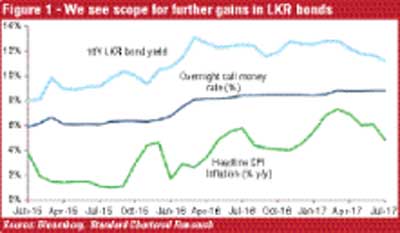Monday Jan 12, 2026
Monday Jan 12, 2026
Thursday, 3 August 2017 01:13 - - {{hitsCtrl.values.hits}}
 Standard Chartered Bank’s Global Research has said that more gains are in store for Sri Lanka Bonds due to their performance and the Government’s recent policy progress.
Standard Chartered Bank’s Global Research has said that more gains are in store for Sri Lanka Bonds due to their performance and the Government’s recent policy progress.
It said rupee local-currency government bonds have performed very well since SCB initiated a long position in April.
“We see scope for further gains in rupee bonds given the Government’s recent policy progress, softening private sector credit growth and a resilient rupee. We therefore extend the target on our trade recommendation to 10.00% from 10.50%, and lower our stop-loss level to 11.20% from 12.70%,” SCB Global Research said.
SCB is recommending long 11.50% 2026 bond (entry: 11.85%, target: 10.50%, stop-loss: 12.70%). This bond is currently trading at a bid YTM of 10.70%, while the rupee has been more resilient than market expectations. As a result, the current total return on this trade is 8.3% in dollar terms. This translates into a duration gain of 6.2%, a carry gain (unadjusted for funding cost) of 2.9% and an FX loss of 0.8% (USD-LKR spot entry: 152.30, current: 153.55).
SCB’s key reasons for revising the target are as follows
1. Fiscal reforms are on the right track
The Government has reinforced its commitment to revenue-based fiscal consolidation and introduced a new Inland Revenue Act (IRA) bill in June 2017. The new bill will help to modernise the direct tax code, broaden the tax base and reduce exemptions. We expect Parliament to pass the IRA in H2-2017, with implementation from 2018. Total revenue growth, at 26% y/y in January-April 2017, is broadly in line with the full-year target (adjusting for the four-month period in 2016 when VAT was in force). Expenditure has been front-loaded; we expect the fiscal deficit to narrow to 5% of GDP in 2017 from 5.4% in 2016, although this is wider than the Government target of 4.6%. Fiscal consolidation is a major focus of Sri Lanka’s IMF Extended Fund Facility (EFF) program. As part of the program, the Government aims to reduce the general Government fiscal deficit to 3.5% of GDP by 2020 from 7.4% in 2015.
2. Inflation and private-sector credit growth are slowing
We think near-term inflation peaked in April at 6.9% y/y. We expect H2-2017 inflation to average c.5%, versus 6.4% in H1-2017. Inflation is likely to decline gradually to 5.0-5.5% in Q3-2017 and subsequently to 5.0% in Q4, as food prices soften. Core inflation also corrected to 4.9% in July from 7.1% in January, and we expect it to decline to 4.2% by December 2017.
Simultaneously, private sector credit growth is slowing, although it is still at the upper bound of the Central Bank of Sri Lanka’s (CBSL’s) comfort range of 15-20% (at 20% in April). Monthly private sector credit disbursal declined to Rs. 20-30 billion in April and May from an average of Rs. 70 billion in the previous 12 months. We will monitor credit disbursal over the next quarter to see if the trend persists. We believe the transmission of monetary policy tightening is effective and the end of the tightening cycle is approaching. This is the key reason for our view that long-end rupee bonds still offer value at current levels.
3. FX risks look manageable
We maintain our USD-LKR forecast of 155 for December 2017, as capital account dynamics are likely to remain favourable. The signing of the $ 1.12 billion Hambantota Port deal in July 2017 is likely to alleviate further near-term BoP concerns. As a part of the deal, the Sri Lanka Treasury will receive $ 973 million by January 2018. Consistent with its stated objective of improving exchange rate flexibility in the short term and maintaining a more competitive real effective exchange rate (REER) in the medium term, the CBSL has allowed the rupee to depreciate over the past year, intervening only to smooth volatility. The CBSL has purchased $ 722 million since March 2017, consistent with our view that it is now trying to build FX reserves (compared to net selling of $ 367 million between October 2016 and February 2017).
